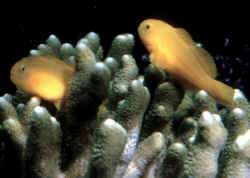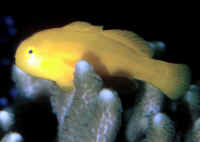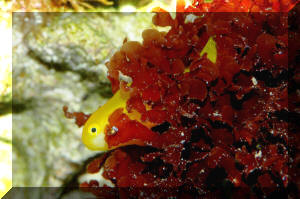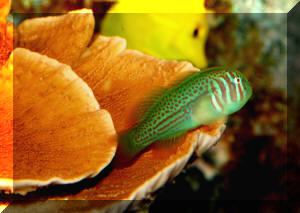|
Related FAQs: Clown Gobies,
Gobiodons 2, Gobiodon Identification,
Gobiodon Behavior, Gobiodon Compatibility, Gobiodon Selection, Gobiodon Systems, Gobiodon Feeding, Gobiodon Disease, Gobiodon Reproduction, Gobiids:
True Gobies, Gobies 2, Goby Identification, Goby Behavior, Goby Selection, Goby Compatibility, Goby Feeding, Goby Systems, Goby Disease, Goby Reproduction, Amblygobius Gobies,
Neon Gobies, Genus Coryphopterus Gobies, Mudskippers, Shrimp Gobies, Sifter Gobies,
Related Articles: True or
Combtooth Gobies, Gobioids in
General,
/The Conscientious Reef Aquarist
Clown Gobies,
Genus Gobiodon
|

|
|
By Bob Fenner
|
Gobiodon
okinawae
|
Clown or Coral Gobies, The Genus
Gobiodon. Thirteen species.
I must mention these tiny chubsters; they've got to
be close to the best fishes for reef and "mixed" aquariums.
Though only attaining a miniscule 2 1/2 inches, Gobiodon are
huge on color and spunky personality. Due to their noxious body slime
no other fish bothers them, and they're happy as proverbial clams
with some Acropora coral to live and feed on or their skeleton
and a little live meaty food. Coral gobies should only be housed with
non-aggressive feeders such as Cardinals, Seahorses and Pipefishes.
When kept as a small group they readily form pairs and
mate. The genus are hermaphrodites, with females turning into males.
The female deposits circular bands around a branch of host coral that
are immediately fertilized and subsequently guarded by the male.
Perhaps owing to their small size, rearing the young has not proved
easy.
The lemon-drop-like Citron Goby, Gobiodon citrinus
is the most commonly kept. The equally adaptable Yellow Goby is
frequently mixed and sold as the citron; it lacks the latter's
beautiful blue and white lines. Also check out the gorgeous
blue-spotted coral goby, Gobiodon histrio; often mis-identified
as Gobiodon rivulatus.
Keep your eyes open for the coral gobies of the genus
Gobiodon and do try them if you have a mixed
invertebrate/peaceful fish set-up or reef system with Acropora polyps
to spare... as this is what this genus largely lives and feeds on in
the wild. Found in the wild with small damsels and juvenile hawkfish
which share their Acroporid perches.
| Gobiodon citrinus (Ruppell 1838), the
Citron or Poison Goby. Indo-Pacific; Red Sea, African coast to
Samoa. Found in close association with table top Acropora species.
To two and a half inches in maximum length. Below:
"Normal" and dark ones in captivity, and one in the Red
Sea in a typical setting, on top of its table coral domain. |
| Gobiodon okinawae Sawara, Arai & Abe
1972. To 3.5 cm. in length. Western Pacific; southern Japan to GBR,
Micronesia. Live on and amongst Acropora coral stands in the wild
in groups of 5-15 individuals. Aquarium image. |

|
| Verticals (Full/Cover
Page Sizes Available) |
.JPG) |
| Bigger PIX: The images in this table are linked
to large (desktop size) copies. Click on "framed" images
to go to the larger size. |
 |
Bigger PIX:
The images in this table are linked
to large (desktop size) copies. Click on "framed" images
to go to the larger size. |
 |

